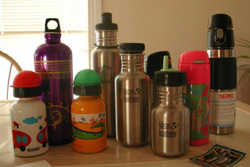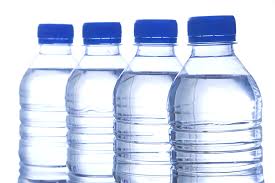Plastic Water Bottle Safety
by Cathe Olson
Although the FDA has approved all plastics currently being used to package food, they might not all be safe. An estrogen-like compound in plastic could be posing risks to the brain development of infants and children. BPA, a component of polycarbonate plastic, can leach from baby bottles, water bottles and other hard plastic containers.
The biggest risk seems to be for fetuses, pregnant women, infants, and children. Low doses of BPA cause structural changes in the brain that trigger learning deficits and hyperactivity. There is also some concern that it harms the prostate gland and causes premature puberty.
Not all plastics have been identified as unsafe. Out of the seven types of plastics used in packaging, four are still considered safe. You can use the recycling number on the bottom of containers to identify the type of plastic being used.
Plastics To Avoid:
- #3 PVC or vinyl: Used in plastic wraps, food containers, soft bottles, wrappings for meat and cheese. It is made with chlorine and releases dioxins which have been linked to cancer (including breast and prostate), hormonal imbalances, high blood pressure, heart disease, autoimmune disease, weight problems, and chronic fatigue. Phthalates, which make the plastic flexible and used in products ranging from shampoo to floor coverings, have recently been cited in a study that linked their exposure to smaller genitals in infant boys and an increase in testicular cancer about adults.
- #6 Polystyrene or styrofoam: Used as takeout containers, plastics cups, and cutlery. Its components leach into fatty foods and are believed to interfere with hormones.
#7 Misc. category that includes polycarbonate (PC): Used for most clear-plastic bottles, including 5-gallon water bottles and baby bottles. When heated, they release BPA, a hormone disrupter that imitates the female hormone estradiol which may be linked to breast and ovarian cancer. The US Centers for Disesase Control and Prevention found BPA in the urine of 95% of Americans tested.
Plastics Considered Safe (so far):
- #1 Polyethylene terephthalate (PET or PETE)
- #2 High-density polyethylene (HDPE)
- #4 Low-density polyethylene (LDPE)
- #5 Polypropylene (PP)
Personally, I recommend avoiding plastic food containers as much as possible. Never put hot food in plastic or use plastic dishes in the microwave, as heat increases the leaching of BPA. It is also not recommended to reuse plastic water bottles because as they become worn or scratched, they leach more toxins.
I’ve been searching for good quality non-plastic water bottles for my family. Although glass bottles are a toxin-free choice, they are not always practical. I wouldn’t send my kids to school or the pool with glass bottles, and they are heavy to take along on hikes or to the beach.
I tested some of the leading nonplastic water bottles to see if I could find one that was durable, easy to use and clean and, most importantly, did not leak. Following are my reviews.

SIGG Water Bottles
www.mysigg.com
SIGG bottles are aluminum with a water-based, non-toxic coating that is baked into the interior walls and remains flexible and crack resistant for the life of the bottle. This special lining is taste neutral and resistant to fruit acids and energy drinks. SIGG bottles exceed FDA requirements for safety and have been independently tested to prove 0% leaching.
We tested the one-liter bottle with the screw top with a stylish “maharadsha purple” design and the very cute kids bottles with the “croco” and “little fireman” designs. All bottles were absolutely leakproof. The adult bottles hold a lot of water—great for hiking or the beach. They’re too wide to fit in a bike holder, however. For that, you’ll want to get one of their sports models. The kids bottles we tried are small and cute with bright pictures—excellent for a toddler or preschooler.
Klean Kanteen
www.kleankanteen.com
Klean Kanteen water bottles are made from stainless steel of the same grade used by dairy and brewery industries. They are plain in design, but sturdy and durable. All bottles have wide openings for easy cleaning.
We tried the 12-ounce bottle which is topped with a plastic (#5 polypropylene) sippy cup top, perfect for small children. The bottle does not leak when tipped over; the only way I got it to leak was to shake it very hard. We also tested the 18-ounce model which is sealed with a plastic screw top and the 27-ounce bottle with the sports top. Although the screw top model was totally leakproof, my daughters often spilled water on themselves when drinking from the wide opening—especially in the car. My husband and I loved the sports-top bottle. It fits right in a bike holder and is great at the gym.
Thermos Beverage Bottles
www.thermos.com
Thermos beverage bottles are made of stainless steel interior and exterior with a push button lids. They have a double wall vacuum insulation to keep beverages cold for 12 hours.
We tried the adult Hydration Bottle 2465 and the FUNtainer bottles for kids My daughters LOVED the FUNtainers—both the design and the fun pop-up lid with the straw. I was very happy with the adult bottle as well. The pop up lid and small spout was excellent for the gym and it’s large enough to hold 18 ounces of water. Both bottles were leakproof and have a fairly wide mouth for cleaning.


